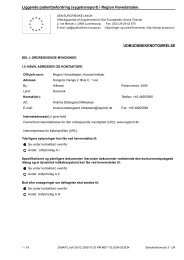Territorial Review Copenhagen - Region Hovedstaden
Territorial Review Copenhagen - Region Hovedstaden
Territorial Review Copenhagen - Region Hovedstaden
Create successful ePaper yourself
Turn your PDF publications into a flip-book with our unique Google optimized e-Paper software.
228<br />
OECD country. In a majority of countries, borrowing needs prior approval<br />
of another government tier, or is restricted to certain purposes. In several<br />
OECD countries, there are no restrictions on access to sub-national<br />
borrowing. Danish municipalities can in certain limited cases acquire debt<br />
for investment. The general law and the yearly agreement between the<br />
national government and the municipalities and regions specify the areas<br />
where the sub-national governments are allowed to acquire debt. As a<br />
general rule, the municipalities are allowed to acquire debt to finance<br />
investments in supply companies (like renovation companies, etc.) as long<br />
as the expenses and the revenues for these companies are neutral in the long<br />
run. The central government uses certain budget safeguards to ensure that<br />
revenue fluctuations do not become too large. Danish municipalities can<br />
own public enterprises and utilities; there are additional limitations on<br />
borrowing by and from these enterprises. Local governments in Denmark<br />
used sale-and-lease-back operations to circumvent borrowing restrictions,<br />
but the Danish central government has revised its definition of borrowing to<br />
include renting and leasing arrangements (Pedersen, 2002). This also<br />
prohibits the use of PPPs.<br />
Not surprisingly, Denmark scores very high on several benchmarks for<br />
sub-national fiscal discipline. It has the highest score of OECD countries on<br />
the Advisory Commission on Intergovernmental Relations (ACIR) index for<br />
budget balance stringency, it has one of the lowest scores under the Inter-<br />
American Development Bank (IADB) sub-national borrowing autonomy<br />
index and one of the highest scores on the OECD composite sub-national<br />
fiscal discipline index – and the highest score on its sub-index on budget<br />
balance and borrowing constraints.<br />
The econometric evidence on the impact of borrowing constraints on<br />
sub-national fiscal policy has so far been limited and mixed, ranging from<br />
increased indebtedness, no effects to some effects (Singh and Plekhanov,<br />
2005). Losses in aggregate efficiency are a potential problem with budget<br />
balance requirements and borrowing constraints. Hard budget constraints<br />
can be too ―hard‖ and discourage investment that is socially efficient<br />
(Besfamille and Lockwood, 2004). Significant allocative inefficiencies may<br />
occur because a rule that covers total spending may be biased against<br />
investment, since capital spending is easier to change than current<br />
expenditure in the short term. It has been observed that Danish<br />
municipalities, because they are severely constrained by borrowing<br />
restrictions, achieve consumption smoothing through adjustments in<br />
investment activity (Borge et al., 2001).

















